Amt mt set 1 exam - Study guides, Class notes & Summaries
Looking for the best study guides, study notes and summaries about Amt mt set 1 exam? On this page you'll find 7 study documents about Amt mt set 1 exam.
All 7 results
Sort by
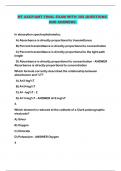
-
AMT MT SET 1 EXAM WITH QUESTIONS AND ANSWERS
- Exam (elaborations) • 101 pages • 2024
- Available in package deal
-
- $9.59
- + learn more
AMT MT SET 1 EXAM WITH QUESTIONS AND ANSWERS ...
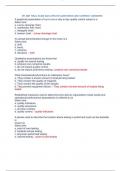
-
MT AMT REAL EXAM 2023 UPDATE QUESTIONS AND CORRECT ANSWERS
- Exam (elaborations) • 40 pages • 2024
-
- $21.99
- + learn more
MT AMT REAL EXAM 2023 UPDATE QUESTIONS AND CORRECT ANSWERS 1. In terms of reasoning, which of the following research is dialectic & inductive? a. Outcome research b. Qualitative research c. Quantitative research d. None of the above 2. Which of the following research utilizes statistics to make generalization? a. Outcome research b. Qualitative research c. Quantitative research d. a and b only 3. Following are the elements of qualitative research except one; a. Reductionist b. Hol...
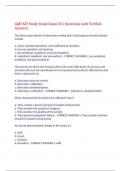
-
AMT MT Study Guide Exam 551 Questions with Verified Answers,100% CORRECT
- Exam (elaborations) • 130 pages • 2024
-
- $13.99
- + learn more
AMT MT Study Guide Exam 551 Questions with Verified Answers The three major phases of laboratory testing that a QA program should evaluate include a. mean, standard deviation, and coefficient of variation. b. pre-op, operative, and post-op. c. pre-analytical, analytical, and post-analytical. d. outpatient, inpatient, and non-patient. - CORRECT ANSWER c. pre-analytical, analytical, and post-analytical. The process by which test results achieve the same high levels of accuracy and prec...
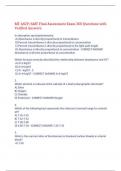
-
MT ASCP/AMT Final Assessment Exam 300 Questions with Verified Answers,100% CORRECT
- Exam (elaborations) • 65 pages • 2024
-
- $13.49
- + learn more
MT ASCP/AMT Final Assessment Exam 300 Questions with Verified Answers In absorption spectrophotometry: A) Absorbance is directly proportional to transmittance B) Percent transmittance is directly proportional to concentration C) Percent transmittance is directly proportional to the light path length D) Absorbance is directly proportional to concentration - CORRECT ANSWER Absorbance is directly proportional to concentration Which formula correctly described the relationship between ...
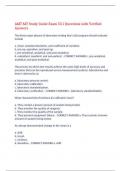
-
AMT MT Study Guide Exam 551 Questions with Verified Answers,100% CORRECT
- Exam (elaborations) • 130 pages • 2024
-
- $13.49
- + learn more
AMT MT Study Guide Exam 551 Questions with Verified Answers The three major phases of laboratory testing that a QA program should evaluate include a. mean, standard deviation, and coefficient of variation. b. pre-op, operative, and post-op. c. pre-analytical, analytical, and post-analytical. d. outpatient, inpatient, and non-patient. - CORRECT ANSWER c. pre-analytical, analytical, and post-analytical. The process by which test results achieve the same high levels of accuracy and prec...

-
MT ASCP/AMT Final Assessment Exam 300 Questions with Verified Answers,100% CORRECT
- Exam (elaborations) • 65 pages • 2024
-
- $12.99
- + learn more
MT ASCP/AMT Final Assessment Exam 300 Questions with Verified Answers In absorption spectrophotometry: A) Absorbance is directly proportional to transmittance B) Percent transmittance is directly proportional to concentration C) Percent transmittance is directly proportional to the light path length D) Absorbance is directly proportional to concentration - CORRECT ANSWER Absorbance is directly proportional to concentration Which formula correctly described the relationship between ...
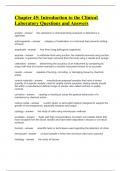
-
Chapter 45: Introduction to the Clinical Laboratory Questions and Answers
- Exam (elaborations) • 13 pages • 2024
- Available in package deal
-
- $12.99
- + learn more
Chapter 45: Introduction to the Clinical Laboratory Questions and Answers analyte the substance or chemical being analyzed or detected in a specimen anticoagulants category of medication or a chemical that prevents clotting of blood aseptically free from living pathogenic organisms aspirate to withdraw fluid using suction; the material removed using suction; example: a specimen that has been removed from the body using a needle and syringe calibration determinin...

That summary you just bought made someone very happy. Also get paid weekly? Sell your study resources on Stuvia! Discover all about earning on Stuvia


